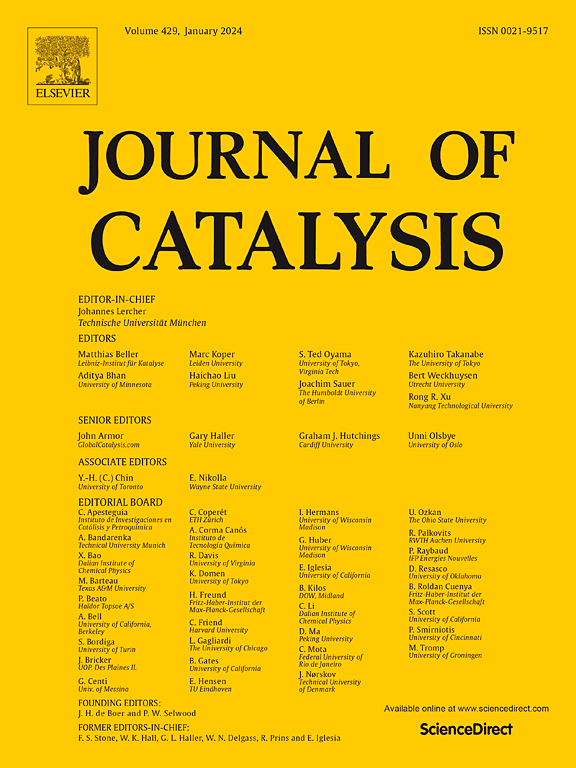Easily synthesized self-nitrogen doped carbon-supported nickel bio-based sustainable catalyst for hydrogenation of benzylamine from benzonitrile
IF 6.5
1区 化学
Q2 CHEMISTRY, PHYSICAL
引用次数: 0
Abstract
Benzylamine production from the hydrogenation of nitrile is attractive, but most of the catalysts are complicated and costly. In this paper, a simple synthesis of self-nitrogen-doped carbon-supported nickel biobased sustainable catalyst (Ni-JKS-600) for benzylamine hydrogenation with benzonitrile has been reported. The catalyst has high specific surface area, abundant micro-mesoporous structure and nickel hydrogenation active site. By optimizing the reaction conditions, a mild reaction condition (120 ℃, 2 MPa H2, 3 h) was determined, and it was found that the solvent had a significant effect on the selectivity of benzylamine, and the selectivity of benzylamine could reach 97.08 % when ammonia methanol was used as the solvent. Ni-JKS-600 catalyst is superior to precious metal catalysts (Ru, Pt, Ir, Pd) in aniline selectivity, and is comparable to Raney nickel catalyst, which shows its potential application in industrial production of amines. The catalyst uses cheap and widely available chitin as carbon and nitrogen source, and has the characteristics of green economy with simple preparation method and low cost. It is expected to replace precious metal catalyst for efficient production of benzylamine in the future.


易于合成自氮掺杂碳负载镍生物基苯甲腈加氢苯胺催化剂
丁腈加氢制苯胺是一种很有吸引力的方法,但大多数催化剂都很复杂且价格昂贵。本文报道了一种简单合成的自氮掺杂碳负载镍基生物基苯甲胺加氢催化剂(Ni-JKS-600)。该催化剂具有高比表面积、丰富的微介孔结构和镍加氢活性位点。通过对反应条件的优化,确定了较温和的反应条件(120℃,2 MPa H2, 3 h),发现溶剂对苄胺的选择性有显著影响,以氨甲醇为溶剂时,苄胺的选择性可达97.08 %。Ni-JKS-600催化剂的苯胺选择性优于贵金属催化剂(Ru、Pt、Ir、Pd),可与Raney镍催化剂相媲美,在工业生产中具有潜在的应用前景。该催化剂采用廉价且广泛使用的几丁质作为碳源和氮源,制备方法简单,成本低,具有绿色经济的特点。在未来有望取代贵金属催化剂高效生产苄胺。
本文章由计算机程序翻译,如有差异,请以英文原文为准。
求助全文
约1分钟内获得全文
求助全文
来源期刊

Journal of Catalysis
工程技术-工程:化工
CiteScore
12.30
自引率
5.50%
发文量
447
审稿时长
31 days
期刊介绍:
The Journal of Catalysis publishes scholarly articles on both heterogeneous and homogeneous catalysis, covering a wide range of chemical transformations. These include various types of catalysis, such as those mediated by photons, plasmons, and electrons. The focus of the studies is to understand the relationship between catalytic function and the underlying chemical properties of surfaces and metal complexes.
The articles in the journal offer innovative concepts and explore the synthesis and kinetics of inorganic solids and homogeneous complexes. Furthermore, they discuss spectroscopic techniques for characterizing catalysts, investigate the interaction of probes and reacting species with catalysts, and employ theoretical methods.
The research presented in the journal should have direct relevance to the field of catalytic processes, addressing either fundamental aspects or applications of catalysis.
 求助内容:
求助内容: 应助结果提醒方式:
应助结果提醒方式:


